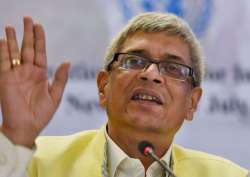Multiple rates a key problem with present GST, says Bibek Debroy
The present GST tax rates are divided into four slabs -- 5 per cent, 12 per cent, 18 per cent and 28 per cent -- as decided by the powerful GST Council headed by Union Finance Minister.

NITI Aayog member and well-known economist Bibek Debroy today said that one of the key problems with the present Goods and Services Tax (GST) regime is its multiple rates structure.
According to Debroy, the multiple rates of GST emanate from the ‘desire to tax items’ which are perceived to be luxury through the means of indirect tax and not the direct ones.
"Please understand these multiple rates are coming from... this desire to drive other ends through indirect tax policy and other concerns of the states. And therefore, you have plenty of exemptions, plenty of items that are outside the GST net and multiple rates," Debroy said.
Besides rates, Debroy said that the present GST set-up might not be perfect but it is a step in that direction.
A single unified tax system is a global fiscal trend. However, the one big difference between the Indian model of GST and similar taxes in other countries is the dual GST model. The present GST tax rates are divided into four slabs -- 5 per cent, 12 per cent, 18 per cent and 28 per cent -- as decided by the powerful GST Council headed by Union Finance Minister.
Many countries in the world have a single unified GST system, countries like Brazil and Canada have a dual GST system whereby GST is levied by both the federal and state or provincial governments. In India, a dual GST is set to take shape whereby a Central Goods and Services Tax (CGST) and a State Goods and Services Tax (SGST) will be levied on the taxable value of every transaction of supply of goods and services.
With IANS Inputs
